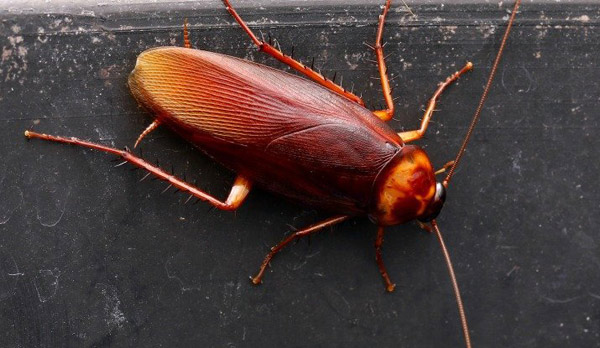當(dāng)前位置: Language Tips> 雙語新聞
Scientists think cockroach milk could be the superfood of the future
分享到

An international team of scientists has just sequenced a protein crystal located in the midgut of cockroaches. The reason?
最近,一個國際科學(xué)家團隊確定了蟑螂中腸內(nèi)的蛋白質(zhì)晶體的結(jié)構(gòu)序列。為什么要研究這個?
It’s more than four times as nutritious as cow’s milk and, the researchers think it could be the key to feeding our growing population in the future.
因為它的營養(yǎng)價值是牛奶的四倍多。研究人員認(rèn)為在人口不斷增長的將來,蟑螂奶可以成為人類的重要食物。
Although most cockroaches don’t actually produce milk, Diploptera punctate, which is the only known cockroach to give birth to live young, has been shown to pump out a type of ‘milk’ containing protein crystals to feed its babies.
盡管大多數(shù)蟑螂自身并不產(chǎn)奶,但有一種斑點折翅類蟑螂,是目前已知的唯一一種胎生蟑螂,它會分泌出一種含有蛋白質(zhì)晶體的“奶”來喂養(yǎng)下一代。
The fact that an insect produces milk is pretty fascinating – but what fascinated researchers is the fact that a single one of these protein crystals contains more than three times the amount of energy found in an equivalent amount of buffalo milk (which is also higher in calories then dairy milk).
昆蟲產(chǎn)奶這一事實本身已十分有趣,但更讓研究者感興趣的是一份蛋白質(zhì)晶體中所含的能量是相同重量的水牛奶的三倍(所含熱量也比相同重量的牛奶多)。
Clearly milking a cockroach isn’t the most feasible option, so an international team of scientists headed by researchers from the Institute of Stem Cell Biology and Regenerative Medicine in India decided to sequence the genes responsible for producing the milk protein crystals to see if they could somehow replicate them in the lab.
顯然,要像擠牛奶一樣擠蟑螂的“奶”并不是個切實可行的方法,所以這個國際科學(xué)家團隊就決定測定控制產(chǎn)生蛋白質(zhì)晶體的基因序列,嘗試在實驗室內(nèi)復(fù)制這組基因。該團隊的領(lǐng)頭人是印度干細(xì)胞生物學(xué)和再生醫(yī)學(xué)研究院的研究人員。
"The crystals are like a complete food - they have proteins, fats and sugars. If you look into the protein sequences, they have all the essential amino acids," said Sanchari Banerjee, one of the team, in an interview with the Times of India.
其中一名隊員桑賈利·班納吉在《印度時報》的采訪中說道:“這些晶體就像完整的食物,有蛋白質(zhì)、脂肪還有糖分。如果你仔細(xì)研究蛋白質(zhì)序列,還會發(fā)現(xiàn)它們含有一切必不可少的氨基酸。”
Not only is the milk a dense source of calories and nutrients, it’s also time released. As the protein in the milk is digested, the crystal releases more protein at an equivalent rate to continue the digestion.
蟑螂奶不僅富含熱量和營養(yǎng)物質(zhì),同時也具有時間控釋性的。當(dāng)奶中的蛋白質(zhì)被消化,晶體會相應(yīng)地釋放出等量的蛋白質(zhì)來繼續(xù)被消化。
"It’s time-released food," said Subramanian Ramaswamy, who led the project. "if you need food that is calorifically high, that is time released and food that is complete. This is it."
研究負(fù)責(zé)人薩布拉馬年·拉馬斯瓦米說:“這是時間控釋性的食物。如果你需要高熱量、具有時間控釋性并且營養(yǎng)全面的食物,那么非它莫屬了。”
It’s important to point out that this dense protein source is definitely never going to be for those trying to lose weight, and probably isn’t even required for most western diets, where we are already eating too many calories per day.
需要指出的是,這種高蛋白質(zhì)的食物并不適合想要減肥的人,也不適合大多數(shù)西方人的飲食,因為西方人每天已經(jīng)攝入了太多的卡路里。
But for those who struggle to get the amount of calories required per day, this could be a quick and easy way to get calories and nutrients.
但是對于那些每天努力要獲得足夠熱量的人來說,這將是他們獲取熱量和營養(yǎng)快捷而簡單的方式。
"They're very stable. They can be a fantastic protein supplement," said Ramaswamy.
拉馬斯瓦米說:“它們十分穩(wěn)定,將會是極好的蛋白質(zhì)補充物。”
Now the researchers have the sequence, they are hoping to get yeast to produce the crystal in much larger quantities- making it slightly more efficient (and less gross) than extracting crystals from cockroach’s guts.
目前科學(xué)家們已經(jīng)測定出了結(jié)構(gòu)序列,他們希望用酵母大量生產(chǎn)這種蛋白質(zhì)晶體,相比直接從蟑螂腸中獲取能更有效率一點,也比較不會令人惡心。
Vocabulary
sequence: 確定……的化學(xué)結(jié)構(gòu)序列
amino acid: 氨基酸
time-released: 隨時間發(fā)揮藥力的,具有時間控釋性的
英文來源:sciencealert
翻譯:王慧雯(中國日報網(wǎng)愛新聞iNews譯者)
審校&編輯:丹妮
上一篇 : 兩萬郵件揭秘希拉里競選黑幕
下一篇 : 百位名人聯(lián)名反對特朗普
分享到
關(guān)注和訂閱


翻譯
關(guān)于我們 | 聯(lián)系方式 | 招聘信息
電話:8610-84883645
傳真:8610-84883500
Email: languagetips@chinadaily.com.cn